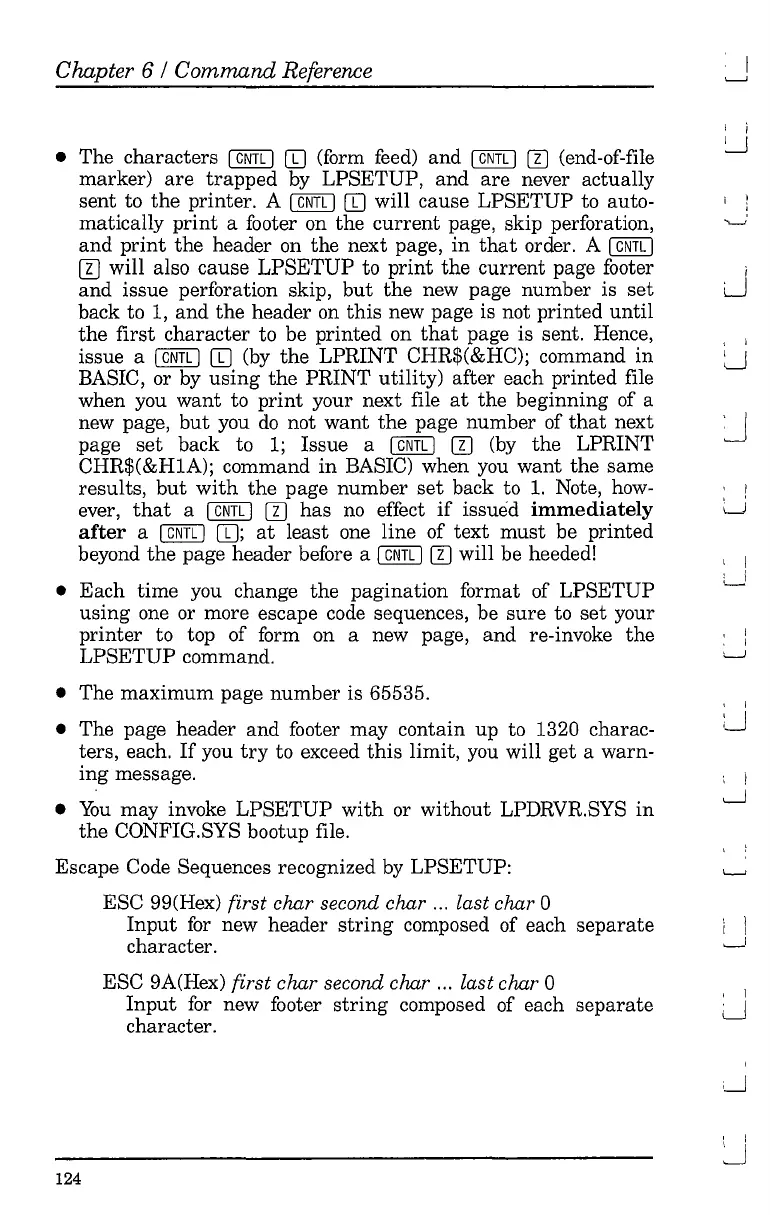Chapter
6/
Command
Reference
• The characters I
CNTL
I
II)
(form feed) and I
CNTL
I
IT]
(end-of-file
marker)
are
trapped
by
LPSETUP, and
are
never actually
sent to
the
printer. A I
CNTL
III)
will cause LPSETUP to auto-
matically
print
a footer on the
current
page, skip perforation,
and
print
the
header on the next page,
in
that
order. A I
CNTL
I
[I]
will also cause LPSETUP to
print
the
current
page footer
and
issue perforation skip,
but
the new page number is
set
back to
1,
and
the
header on
this
new page is not printed
until
the
first character to be printed on
that
page is sent. Hence,
issue a
I
CNTL
I
II)
(by
the
LPRINT CHR$(&HC); command
in
BASIC, or by
using
the
PRINT utility) after each printed file
when you want to
print
your next file
at
the
beginning of a
new page,
but
you
do
not want
the
page number of
that
next
page
set
back to
1;
Issue a I
CNTL
I IT]
(by
the
LPRINT
CHR$(&H1A); command
in
BASIC) when
you
want the same
results,
but
with
the
page number
set
back to
1.
Note, how-
ever,
that
a I
CNTL
I IT] has
no
effect
if
issued
immediately
after
a I
CNTL
I II);
at
least one line of
text
must
be printed
beyond
the
page header before a I
CNTL
IIT] will be heeded!
• Each time you change the pagination format of LPSETUP
using one or more escape code sequences, be
sure
to
set
your
printer to top of form on a new page, and re-invoke the
LPSETUP command.
• The
maximum
page number is 65535.
• The page header and footer may contain up to 1320 charac-
ters, each.
If
you
try
to exceed
this
limit,
you
will get a warn-
ing message.
•
You
may invoke LPSETUP
with
or without LPDRVRSYS
in
the
CONFIG.SYS bootup file.
Escape Code Sequences recognized
by
LPSETUP:
ESC 99(Hex)
first clwr second clwr
...
last clwr 0
Input
for
new header
string
composed of each
separate
character.
ESC 9A(Hex)
first clwr second clwr
...
last clwr 0
Input
for
new footer
string
composed of each
separate
character.
124
I i
~
i
LJ
, I
~
J
, I
l-i
I I
L .
...I
, I
I
L...J
, I
:~
, 1
I !
~I
I I
LJ
